Cryptocurrency trading has witnessed a surge in popularity, and with it, the debate between centralized exchanges (CEXs) vs. decentralized exchanges (DEXs) has grown more pronounced. These two approaches to cryptocurrency trading each come with their own unique set of advantages and disadvantages, making it crucial for anyone entering the cryptocurrency market to comprehend these distinctions. In this comprehensive article, we will delve into how CEX and DEX work, discuss their pros and cons, and analyze the key differences between them.
How does centralized exchange (CEX) work?
In contrast to DEXs, centralized exchanges operate with a central authority that serves as an intermediary between buyers and sellers. They maintain their own order books, hold users’ funds in custody, and oversee the trading activities on their platforms. Some of the most renowned CEXs include Coinbase, Binance, and Kraken.
- Centralized Order Book: CEXs maintain a centralized order book, aggregating buy and sell orders from users on the platform. This setup allows for faster order matching and execution, as all orders are processed within the exchange’s infrastructure.
- Custody of Funds: Users on CEXs entrust the exchange with the custody of their funds. This is a point of concern for many, as it exposes users to the risk of hacks, the exchange’s solvency, or potential regulatory actions.
Pros and Cons of CEX

Pros:
- Liquidity: CEXs generally offer higher liquidity, facilitating the execution of large trades with minimal price slippage. This feature is particularly attractive to professional and high-frequency traders.
- User-Friendly: CEXs often boast more user-friendly interfaces, making them accessible to both beginners and experienced traders. The streamlined experience encourages greater adoption.
- Diverse Asset Selection: CEXs typically provide a wider range of trading pairs, including fiat-to-crypto pairs, expanding the scope of trading opportunities.
Cons:
- Security Risks: Centralized exchanges are susceptible to security breaches, as they hold users’ funds in a centralized repository. If the exchange falls victim to a hack, users’ assets are at risk.
- Privacy Concerns: Many CEXs mandate users to complete KYC procedures, compromising their anonymity and privacy. This data collection aligns with regulatory requirements but may not be appreciated by all users.
- Centralization: CEXs are fundamentally centralized, which runs counter to the decentralized ethos of cryptocurrencies. Centralization introduces vulnerabilities and counteracts the principles of trustlessness that underlie cryptocurrencies.
How does decentralized exchange (DEX) work?
At its core, a decentralized exchange is exactly what its name implies—an exchange that operates without a central authority. It leverages blockchain technology to facilitate peer-to-peer transactions, allowing users to trade directly with one another, eliminating the need for a middleman. The primary components that make up a DEX are smart contracts and a decentralized order book.
- Smart Contracts: Smart contracts are self-executing contracts with the terms of the agreement written directly into code. In the context of a DEX, these contracts are responsible for automating the process of matching and executing orders, thereby ensuring trust and transparency in the absence of a centralized entity.
- Decentralized Order Book: Instead of relying on a centralized order book managed by the exchange, DEXs maintain a decentralized order book directly on the blockchain. This order book displays all available buy and sell orders, enabling users to discover suitable trading partners.
Pros and Cons of DEX

Pros:
- Security: DEXs are widely regarded as more secure than their centralized counterparts (CEXs) because they do not hold users’ funds in a central repository. This reduces the risk of hacks and theft, which have plagued numerous centralized exchanges.
- Privacy: DEXs afford users a higher degree of privacy. They typically do not necessitate users to undergo extensive Know Your Customer (KYC) procedures, allowing traders to maintain a level of anonymity and data protection.
- No Central Authority: DEXs operate without a central authority, a feature that aligns with the foundational principles of blockchain and cryptocurrencies—decentralization.
Cons:
- Liquidity Challenges: DEXs often struggle with liquidity. As a result, trading on a DEX can lead to higher spreads and slower order execution, especially for less popular trading pairs.
- User Experience: User interfaces and experiences on DEXs are frequently considered less user-friendly than those on CEXs. This can be intimidating for beginners and casual traders.
- Limited Asset Selection: DEXs may not support as many trading pairs as CEXs, which limits the diversity of assets available for trading. Users may find that their desired cryptocurrencies are not available on DEXs.
CEX vs. DEX: Key differences

To provide a clearer perspective on the topic, let’s examine the key distinctions between DEXs and CEXs:
- Centralization vs. Decentralization: The most fundamental divergence between CEXs and DEXs is the presence or absence of a central authority. DEXs are decentralized, whereas CEXs are centralized. DEXs operate based on trustless smart contracts, removing the need for trust in a central entity, while CEXs rely on user trust in the exchange.
- Security: DEXs are frequently praised for their enhanced security measures. By not maintaining users’ funds in a centralized wallet, they reduce the risk of large-scale hacks. CEXs, on the other hand, are more susceptible to security breaches due to their centralized nature.
- Privacy: DEXs offer superior privacy since they usually don’t require extensive KYC procedures. Users can trade with a level of anonymity not typically available on CEXs. In contrast, CEXs often mandate KYC compliance to meet regulatory requirements, compromising user privacy.
- Liquidity: CEXs provide higher liquidity, which is crucial for quick order execution and minimal price slippage. DEXs, on the other hand, may struggle with lower liquidity, resulting in slower order execution and wider spreads.
- User Experience: User interfaces and experiences on CEXs are known for their user-friendliness, making them more accessible to beginners. DEXs may have a steeper learning curve, which can be a drawback for those new to cryptocurrency trading.
- Asset Selection: CEXs typically offer a broader selection of trading pairs, including fiat-to-crypto pairs. This variety expands the trading options for users. DEXs may have a limited number of trading pairs, restricting trading opportunities and asset diversity.
Conclusion: CEX vs. DEX
Choosing between a CEX and a DEX hinge on individual needs and preferences. If security, privacy, and adhering to the principles of decentralization are top priorities, then a DEX may be the more suitable choice. On the other hand, if you value high liquidity, access to a wide array of trading pairs, and a user-friendly interface, a CEX might be your preferred option.
It’s important to note that the cryptocurrency landscape is continually evolving. Innovations are emerging that aim to bridge the gap between CEXs and DEXs. Hybrid exchanges, for example, are blending the features of both to provide the best of both worlds.
In making your choice, always conduct thorough research and consider your trading goals and risk tolerance. Keep in mind that the cryptocurrency market is highly dynamic, and new solutions are continually emerging. Whether you opt for a CEX or DEX, prioritize security and responsible trading practices to safeguard your assets in this rapidly evolving ecosystem.


